Nsca cscs study guide - Study guides, Class notes & Summaries
Looking for the best study guides, study notes and summaries about Nsca cscs study guide? On this page you'll find 29 study documents about Nsca cscs study guide.
All 29 results
Sort by
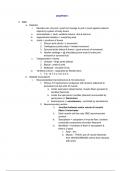
-
Ultimate Chapter-to-Chapter CSCS Summary Outline
- Summary • 83 pages • 2024
-
- $39.99
- 5x sold
- + learn more
Here's an outlined study guide of all 24 chapters of the book "Essentials of Strength Training and Conditioning - 4th edition" that's commonly used to study for the CSCS Exam by NSCA. This preparatory material will be helpful in understanding the most important big picture concepts in each chapter of the book. This chapter-by-chapter outline also gives detailed examples and definitions of topics you will need to know to pass the CSCS Exam. Disclaimer - This document isn't sponsored by nor a...
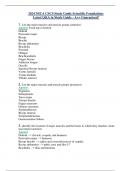
-
2024 NSCA CSCS Study Guide Scientific Foundations Latest Q&A in Study Guide - A++ Guaranteed!
- Exam (elaborations) • 29 pages • 2023
-
Available in package deal
-
- $12.99
- + learn more
2024 NSCA CSCS Study Guide Scientific Foundations Latest Q&A in Study Guide - A++ Guaranteed! 1. List the major muscles and muscle groups (anterior) Answer: From top to bottom Deltoid Pectoralis major Biceps Brachii Rectus abdominis Brachialis External Oblique Brachioradialis Finger flexors Adductor longus Gracilis Sartorius Rectus femoris Vastus lateralis Vastus medialis Tibialis anterior 2. List the major muscles and muscle groups (posterior) Answer: Trapezius Infras...
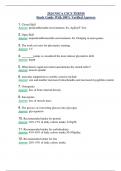
-
2024 NSCA CSCS TERMS Study Guide With 100% Verified Answers
- Exam (elaborations) • 30 pages • 2023
-
- $12.99
- + learn more
2024 NSCA CSCS TERMS Study Guide With 100% Verified Answers 1. Closed Skill Answer: predictable/stable environments. Ex: Agility/T-Test 2. Open Skill Answer: unpredictable/unstable environments. Ex: Dodging in team games 3. The work rest ratio for plyometric training. Answer: 1:5 4. jumps is considered the most intense plyometric drill. Answer: depth 5. What detects rapid movement and initiates the stretch reflex? Answer: muscle spindle 6. muscular adaptations to aerobic exercise i...
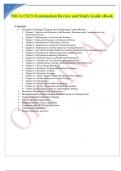
-
NSCA CSCS Examination Review and Study Guide eBook.
- Exam (elaborations) • 221 pages • 2023
- Available in package deal
-
- $22.49
- + learn more
NSCA CSCS Examination Review and Study Guide eBook.
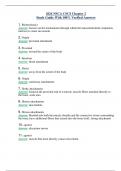
-
2024 NSCA CSCS Chapter 2 Study Guide With 100% Verified Answers
- Exam (elaborations) • 13 pages • 2023
-
Available in package deal
-
- $10.99
- + learn more
2024 NSCA CSCS Chapter 2 Study Guide With 100% Verified Answers 1. Biomechanics Answer: focuses on the mechanisms through which the musculoskeletal compnents interact to create movement 2. Origin Answer: proximal attachment 3. Proximal Answer: toward the center of the body 4. Insertion Answer: distal attachment 5. Distal Answer: away from the center of the body 6. Origin Answer: stationary attachments 7. fleshy attachments Answer: found at the proximal end of a muscle, muscle ...
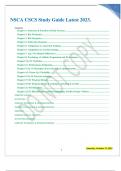
-
NSCA CSCS Study Guide Latest 2023.
- Exam (elaborations) • 71 pages • 2023
- Available in package deal
-
- $8.49
- + learn more
NSCA CSCS Study Guide Latest 2023.
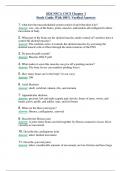
-
2024 NSCA CSCS Chapter 1 Study Guide With 100% Verified Answers
- Exam (elaborations) • 13 pages • 2023
-
Available in package deal
-
- $10.99
- + learn more
2024 NSCA CSCS Chapter 1 Study Guide With 100% Verified Answers 1. what doesthe musculoskeletalsystem consist of and what doesit do? Answer: con- sists of the bones, joints, muscles, and tendons all configured to allow movement of body 2. What part of the brain are the skeletal muscles under control of? and how does it control the skeletal muscles? Answer: The cerebral cortex; it controls the skeletal muscles by activating the skeletal muscle cells or fibers through the motor neurons o...
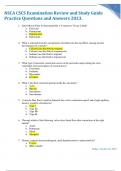
-
NSCA CSCS Examination Review and Study Guide Practice Questions and Answers 2023.
- Exam (elaborations) • 165 pages • 2023
- Available in package deal
-
- $7.99
- + learn more
NSCA CSCS Examination Review and Study Guide Practice Questions and Answers 2023.
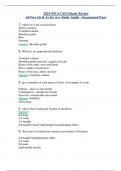
-
2024 NSCA CSCS Study Review All New Qs & As for A++ Study Guide - Guaranteed Pass!
- Exam (elaborations) • 50 pages • 2023
-
Available in package deal
-
- $12.99
- + learn more
2024 NSCA CSCS Study Review All New Qs & As for A++ Study Guide - Guaranteed Pass! 1. which on is not axial skeleton Skull (cranium) Vertebral column Shoulder girdle Ribs Sternum Answer: Shoulder girdle 2. Which is not appendicular skeleton Vertebral column Shoulder girdle (pectoral,scapula clavicle) Bones of the arms, wrist and hands Pelvic girdle (coxal bones) Bones of the legs, ankles and feet Answer: Vertebral column 3. give examples of each types of joints (w/examples of e...
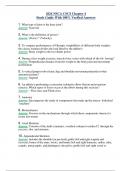
-
2024 NSCA CSCS Chapter 4 Study Guide With 100% Verified Answers
- Exam (elaborations) • 9 pages • 2023
-
Available in package deal
-
- $10.99
- + learn more
2024 NSCA CSCS Chapter 4 Study Guide With 100% Verified Answers 1. What type of joint is the knee joint? Answer: Synovial 2. What is the definition of power? Answer: (Force) * (Velocity) 3. To compare performances of Olympic weightlifters of different body weights, the classic formula divides the load lifted by the athlete's: Answer: Body weight to the two-thirds power 4. During a free weight exercise, muscle force varies with which of the fol- lowing? Answer: Perpendicular distance f...

Study stress? For sellers on Stuvia, these are actually golden times. KA-CHING! Earn from your study resources too and start uploading now. Discover all about earning on Stuvia


